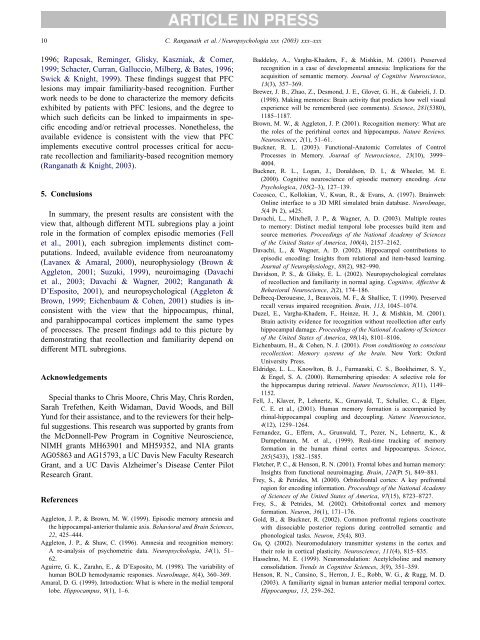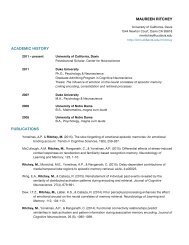10 C. Ranganath et al. / Neuropsychologia xxx (2003) xxx–xxx1996; Rapcsak, Reminger, Glisky, Kaszniak, & Comer,1999; Schacter, Curran, Galluccio, Milberg, & Bates, 1996;Swick & Knight, 1999). These findings suggest that PFClesions may impair <strong>familiarity</strong>-based recognition. Furtherwork needs to be done to characterize the memory deficitsexhibited by patients with PFC lesions, <strong>and</strong> the degree towhich such deficits can be linked to impairments in specificencoding <strong>and</strong>/or retrieval processes. Nonetheless, theavailable evidence is consistent with the view that PFCimplements executive control processes critical for accurate<strong>recollection</strong> <strong>and</strong> <strong>familiarity</strong>-based recognition memory(Ranganath & Knight, 2003).5. ConclusionsIn summary, the present results are consistent with theview that, although different MTL subregions play a jointrole in the formation <strong>of</strong> complex episodic memories (Fellet al., 2001), each subregion implements distinct computations.Indeed, available evidence from neuroanatomy(Lavanex & Amaral, 2000), neurophysiology (Brown &Aggleton, 2001; Suzuki, 1999), neuroimaging (Davachiet al., 2003; Davachi & Wagner, 2002; Ranganath &D’Esposito, 2001), <strong>and</strong> neuropsychological (Aggleton &Brown, 1999; Eichenbaum & Cohen, 2001) studies is inconsistentwith the view that the hippocampus, rhinal,<strong>and</strong> parahippocampal cortices implement the same types<strong>of</strong> processes. The present findings add to this picture bydemonstrating that <strong>recollection</strong> <strong>and</strong> <strong>familiarity</strong> depend ondifferent MTL subregions.AcknowledgementsSpecial thanks to Chris Moore, Chris May, Chris Rorden,Sarah Trefethen, Keith Widaman, David Woods, <strong>and</strong> BillYund for their assistance, <strong>and</strong> to the reviewers for their helpfulsuggestions. This research was supported by grants fromthe McDonnell-Pew Program in Cognitive Neuroscience,NIMH grants MH63901 <strong>and</strong> MH59352, <strong>and</strong> NIA grantsAG05863 <strong>and</strong> AG15793, a UC Davis New Faculty ResearchGrant, <strong>and</strong> a UC Davis Alzheimer’s Disease Center PilotResearch Grant.ReferencesAggleton, J. P., & Brown, M. W. (1999). Episodic memory amnesia <strong>and</strong>the hippocampal-anterior thalamic axis. Behavioral <strong>and</strong> Brain Sciences,22, 425–444.Aggleton, J. P., & Shaw, C. (1996). Amnesia <strong>and</strong> recognition memory:A re-analysis <strong>of</strong> psychometric data. Neuropsychologia, 34(1), 51–62.Aguirre, G. K., Zarahn, E., & D’Esposito, M. (1998). The variability <strong>of</strong>human BOLD hemodynamic responses. NeuroImage, 8(4), 360–369.Amaral, D. G. (1999). Introduction: What is where in the medial temporallobe. Hippocampus, 9(1), 1–6.Baddeley, A., Vargha-Khadem, F., & Mishkin, M. (2001). Preservedrecognition in a case <strong>of</strong> developmental amnesia: Implications for theacquisition <strong>of</strong> semantic memory. Journal <strong>of</strong> Cognitive Neuroscience,13(3), 357–369.Brewer, J. B., Zhao, Z., Desmond, J. E., Glover, G. H., & Gabrieli, J. D.(1998). Making memories: Brain activity that predicts how well visualexperience will be remembered (see comments). Science, 281(5380),1185–1187.Brown, M. W., & Aggleton, J. P. (2001). Recognition memory: What arethe roles <strong>of</strong> the perirhinal cortex <strong>and</strong> hippocampus. Nature Reviews.Neuroscience, 2(1), 51–61.Buckner, R. L. (2003). Functional-Anatomic Correlates <strong>of</strong> ControlProcesses in Memory. Journal <strong>of</strong> Neuroscience, 23(10), 3999–4004.Buckner, R. L., Logan, J., Donaldson, D. I., & Wheeler, M. E.(2000). Cognitive neuroscience <strong>of</strong> episodic memory encoding. ActaPsychologica, 105(2–3), 127–139.Cocosco, C., Kollokian, V., Kwan, R., & Evans, A. (1997). Brainweb:Online interface to a 3D MRI simulated brain database. NeuroImage,5(4 Pt 2), s425.Davachi, L., Mitchell, J. P., & Wagner, A. D. (2003). Multiple routesto memory: Distinct medial temporal lobe processes build item <strong>and</strong>source memories. Proceedings <strong>of</strong> the National Academy <strong>of</strong> Sciences<strong>of</strong> the United States <strong>of</strong> America, 100(4), 2157–2162.Davachi, L., & Wagner, A. D. (2002). Hippocampal contributions toepisodic encoding: Insights from relational <strong>and</strong> item-based learning.Journal <strong>of</strong> Neurophysiology, 88(2), 982–990.Davidson, P. S., & Glisky, E. L. (2002). Neuropsychological <strong>correlates</strong><strong>of</strong> <strong>recollection</strong> <strong>and</strong> <strong>familiarity</strong> in normal aging. Cognitive, Affective &Behavioral Neuroscience, 2(2), 174–186.Delbecq-Derouesne, J., Beauvois, M. F., & Shallice, T. (1990). Preservedrecall versus impaired recognition. Brain, 113, 1045–1074.Duzel, E., Vargha-Khadem, F., Heinze, H. J., & Mishkin, M. (2001).Brain activity evidence for recognition without <strong>recollection</strong> after earlyhippocampal damage. Proceedings <strong>of</strong> the National Academy <strong>of</strong> Sciences<strong>of</strong> the United States <strong>of</strong> America, 98(14), 8101–8106.Eichenbaum, H., & Cohen, N. J. (2001). From conditioning to conscious<strong>recollection</strong>: Memory systems <strong>of</strong> the brain. New York: OxfordUniversity Press.Eldridge, L. L., Knowlton, B. J., Furmanski, C. S., Bookheimer, S. Y.,& Engel, S. A. (2000). Remembering episodes: A selective role forthe hippocampus during retrieval. Nature Neuroscience, 3(11), 1149–1152.Fell, J., Klaver, P., Lehnertz, K., Grunwald, T., Schaller, C., & Elger,C. E. et al., (2001). Human memory formation is accompanied byrhinal-hippocampal coupling <strong>and</strong> decoupling. Nature Neuroscience,4(12), 1259–1264.Fern<strong>and</strong>ez, G., Effern, A., Grunwald, T., Pezer, N., Lehnertz, K., &Dumpelmann, M. et al., (1999). Real-time tracking <strong>of</strong> memoryformation in the human rhinal cortex <strong>and</strong> hippocampus. Science,285(5433), 1582–1585.Fletcher, P. C., & Henson, R. N. (2001). Frontal lobes <strong>and</strong> human memory:Insights from functional neuroimaging. Brain, 124(Pt 5), 849–881.Frey, S., & Petrides, M. (2000). Orbit<strong>of</strong>rontal cortex: A key prefrontalregion for encoding information. Proceedings <strong>of</strong> the National Academy<strong>of</strong> Sciences <strong>of</strong> the United States <strong>of</strong> America, 97(15), 8723–8727.Frey, S., & Petrides, M. (2002). Orbit<strong>of</strong>rontal cortex <strong>and</strong> memoryformation. Neuron, 36(1), 171–176.Gold, B., & Buckner, R. (2002). Common prefrontal regions coactivatewith dissociable posterior regions during controlled semantic <strong>and</strong>phonological tasks. Neuron, 35(4), 803.Gu, Q. (2002). Neuromodulatory transmitter systems in the cortex <strong>and</strong>their role in cortical plasticity. Neuroscience, 111(4), 815–835.Hasselmo, M. E. (1999). Neuromodulation: Acetylcholine <strong>and</strong> memoryconsolidation. Trends in Cognitive Sciences, 3(9), 351–359.Henson, R. N., Cansino, S., Herron, J. E., Robb, W. G., & Rugg, M. D.(2003). A <strong>familiarity</strong> signal in human anterior medial temporal cortex.Hippocampus, 13, 259–262.
C. Ranganath et al. / Neuropsychologia xxx (2003) xxx–xxx 11Henson, R. N. A., Rugg, M. D., Shallice, T., Josephs, O., & Dolan,R. J. (1999). Recollection <strong>and</strong> <strong>familiarity</strong> in recognition memory: Anevent-related functional magnetic resonance imaging study. Journal <strong>of</strong>Neuroscience, 19(10), 3962–3972.Holdstock, J. S., Mayes, A. R., Roberts, N., Cezayirli, E., Isaac, C.L., & O’Reilly, R. C. (2002). Under what conditions is recognitionspared relative to recall after selective hippocampal damage in humans.Hippocampus, 12(3), 341–351.Janowsky, J. S., Shimamura, A. P., & Squire, L. R. (1989). Source memoryimpairment in patients with frontal lobe lesions. Neuropsychologia,27(8), 1043–1056.Kirchh<strong>of</strong>f, B. A., Wagner, A. D., Maril, A., & Stern, C. E. (2000).Prefrontal-temporal circuitry for episodic encoding <strong>and</strong> subsequentmemory. Journal <strong>of</strong> Neuroscience, 20(16), 6173–6180.Kishiyama, M. M., & Yonelinas, A. P. Novelty effects on <strong>recollection</strong> <strong>and</strong><strong>familiarity</strong> in recognition memory. Memory & Cognition, in press.Knowlton, B. J., & Squire, L. R. (1995). Remembering <strong>and</strong> knowing: Twodifferent expressions <strong>of</strong> declarative memory. Journal <strong>of</strong> ExperimentalPsychology, Learning, Memory, <strong>and</strong> Cognition, 21(3), 699–710.Lavanex, P., & Amaral, D. (2000). Hippocampal-neocortical interaction:A hierarchy <strong>of</strong> associativity. Hippocampus, 10, 420–430.Manns, J. R., Hopkins, R. O., Reed, J. M., Kitchener, E. G., & Squire, L.R. (2003). Recognition memory <strong>and</strong> the human hippocampus. Neuron,37(1), 171–180.Mayes, A. R., Holdstock, J. S., Isaac, C. L., Hunkin, N. M., & Roberts,N. (2002). Relative sparing <strong>of</strong> item recognition memory in a patientwith adult-onset damage limited to the hippocampus. Hippocampus,12(3), 325–340.McAndrews, M. P., & Milner, B. (1991). The frontal cortex <strong>and</strong> memoryfor temporal order. Neuropsychologia, 29(9), 849–859.Mesulam, M. M., & Mufson, E. J. (1984). Neural inputs into the nucleusbasalis <strong>of</strong> the substantia innominata (Ch4) in the rhesus monkey. Brain,107(Pt 1), 253–274.Moscovitch, M. (2000). Theories <strong>of</strong> memory <strong>and</strong> consciousness. In E.Tulving & F. I. Craik (Eds.), The Oxford h<strong>and</strong>book <strong>of</strong> memory(pp. 609–625). New York: Oxford University Press.Moscovitch, D. A., & McAndrews, M. P. (2002). Material-specific deficitsin “remembering” in patients with unilateral temporal lobe epilepsy<strong>and</strong> excisions. Neuropsychologia, 40(8), 1335–1342.O’Reilly, R. C., & Norman, K. A. (2002). Hippocampal <strong>and</strong> neocorticalcontributions to memory: Advances in the complementary learningsystems framework. Trends in Cognitive Sciences, 6(12), 505–510.O’Reilly, R. C., & Rudy, J. W. (2001). Conjunctive representations inlearning <strong>and</strong> memory: Principles <strong>of</strong> cortical <strong>and</strong> hippocampal function.Psychology Review, 108(2), 311–345.Otten, L. J., Henson, R. N., & Rugg, M. D. (2001). Depth <strong>of</strong> processingeffects on neural <strong>correlates</strong> <strong>of</strong> memory encoding: Relationship betweenfindings from across- <strong>and</strong> within-task comparisons. Brain, 124(Pt 2),399–412.Paller, K. A., & Wagner, A. D. (2002). Observing the transformation <strong>of</strong>experience into memory. Trends in Cognitive Sciences, 6(2), 93–102.Postle, B. R., Zarahn, E., & D’Esposito, M. (2000). Using event-relatedfMRI to assess delay-period activity during performance <strong>of</strong> spatial <strong>and</strong>nonspatial working memory tasks. Brain Research. Brain ResearchProtocols, 5(1), 57–66.Ranganath, C., & D’Esposito, M. (2001). Medial temporal lobe activityassociated with active maintenance <strong>of</strong> novel information. Neuron, 31,865–873.Ranganath, C., Johnson, M. K., & D’Esposito, M. (2003). Prefrontalactivity associated with working memory <strong>and</strong> episodic long-termmemory. Neuropsychologia, 41(3), 378–389.Ranganath, C., & Knight, R. T., (2003). Prefrontal cortex <strong>and</strong> episodicmemory: Integrating findings from neuropsychology <strong>and</strong> event-relatedfunctional neuroimaging. In A. Parker, E. Wildng, & T. Bussey(Eds.), The Cognitive Neuroscience <strong>of</strong> Memory Encoding <strong>and</strong> Retrieval.Philadelphia: Psychology Press, pp. 83–99.Ranganath, C., & Rainer, G. (2003). Neural mechanisms for detecting<strong>and</strong> remembering novel events. Nature Reviews. Neuroscience, 4(3),193–202.Rapcsak, S. Z., Kaszniak, A. W., Reminger, S. L., Glisky, M. L., Glisky, E.L., & Comer, J. F. (1998). Dissociation between verbal <strong>and</strong> autonomicmeasures <strong>of</strong> memory following frontal lobe damage. Neurology, 50,1259–1265.Rapcsak, S. Z., Polster, M. R., Glisky, M. R., & Comer, J. F. (1996). Falserecognition <strong>of</strong> unfamiliar faces following right hemisphere damage:Neuropsychological <strong>and</strong> anatomical observations. Cortex, 32, 593–611.Rapcsak, S. Z., Reminger, S. L., Glisky, E. L., Kaszniak, A. W., &Comer, J. F. (1999). Neuropsychological mechanisms <strong>of</strong> false facialrecognition following frontal lobe damage. Cognitive Neuropsychology,16, 267–292.Reber, P. J., Siwiec, R. M., Gitleman, D. R., Parrish, T. B., Mesulam, M.M., & Paller, K. A. (2002). Neural <strong>correlates</strong> <strong>of</strong> successful encodingidentified using functional magnetic resonance imaging. Journal <strong>of</strong>Neuroscience, 22(21), 9541–9548.Schacter, D. L., Curran, T., Galluccio, L., Milberg, W. P., & Bates, J.F. (1996). False recognition <strong>and</strong> the right frontal lobe: A case study.Neuropsychologia, 34(8), 793–808.Shastri, L. (2002). Episodic memory <strong>and</strong> cortico-hippocampal interactions.Trends in Cognitive Sciences, 6(4), 162–168.Squire, L. R., & Knowlton, B. J. (2000). The medial temporal lobe, thehippocampus, <strong>and</strong> the memory systems <strong>of</strong> the brain. In M. S. Gazzaniga(Ed.), The new cognitive neurosciences (2nd ed., pp. 765–779).Cambridge: MIT Press.Stark, C. E., & Squire, L. R. (2001). Simple <strong>and</strong> associative recognitionmemory in the hippocampal region. Learning & Memory, 8(4), 190–197.Stark, C. E., & Squire, L. R. (2003). Hippocampal damage equally impairsmemory for single items <strong>and</strong> memory for conjunctions. Hippocampus,13(2), 281–292.Strange, B. A., Otten, L. J., Josephs, O., Rugg, M. D., &Dolan, R. J. (2002). <strong>Dissociable</strong> human perirhinal hippocampal<strong>and</strong> parahippocampal roles during verbal encoding. Journal <strong>of</strong>Neuroscience, 22(2), 523–528.Stuss, D. T., Alex<strong>and</strong>er, M. P., Palumbo, C. L., Buckle, L., Sayer,L., & Pogue, J. (1994). Organizational strategies <strong>of</strong> patients withunilateral or bilateral frontal lobe injury in word list learning tasks.Neuropsychology, 8, 355–373.Suzuki, W. A. (1999). The long <strong>and</strong> the short <strong>of</strong> it: Memory signals inthe medial temporal lobe. Neuron, 24(2), 295–298.Swick, D., & Knight, R. T. (1999). Contributions <strong>of</strong> prefrontal cortexto recognition memory: Electrophysiological <strong>and</strong> behavioral evidence.Neuropsychology, 13(2), 155–170.Thompson-Schill, S. L., D’Esposito, M., Aguirre, G. K., & Farah, M. J.(1997). Role <strong>of</strong> left inferior prefrontal cortex in retrieval <strong>of</strong> semanticknowledge: A reevaluation. Proceedings <strong>of</strong> the National Academy <strong>of</strong>Sciences <strong>of</strong> the United States <strong>of</strong> America, 94(26), 14792–14797.Wagner, A. D. (1999). Working memory contributions to human learning<strong>and</strong> remembering. Neuron, 22, 19–22.Wagner, A. D., Pare-Blagoev, E. J., Clark, J., & Poldrack, R. A. (2001).Recovering meaning: Left prefrontal cortex guides controlled semanticretrieval. Neuron, 31(2), 329–338.Worsley, K. J., & Friston, K. J. (1995). Analysis <strong>of</strong> fMRI time-seriesrevisited—again. NeuroImage, 2, 173–182.Yonelinas, A. P. (2001). Consciousness control <strong>and</strong> confidence: The 3 Cs<strong>of</strong> recognition memory. Journal <strong>of</strong> Experimental Psychology: General,130(3), 361–379.Yonelinas, A. P. (2002). The nature <strong>of</strong> <strong>recollection</strong> <strong>and</strong> <strong>familiarity</strong>: Areview <strong>of</strong> 30 years <strong>of</strong> research. Journal <strong>of</strong> Memory <strong>and</strong> Language,46(3), 441–517.Yonelinas, A. P., Hopfinger, J. B., Buonocore, M. H., Kroll, N.E. A., & Baynes, K. (2001). Hippocampal parahippocampal, <strong>and</strong>occipital-temporal contributions to associative <strong>and</strong> item recognitionmemory: An fMRI study. NeuroReport, 12(2), 359–363.




